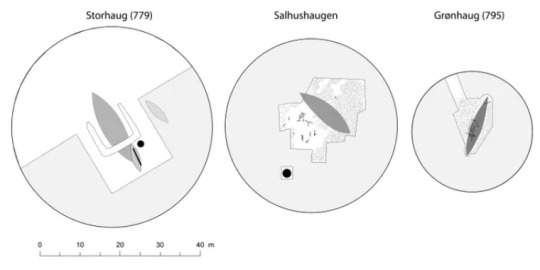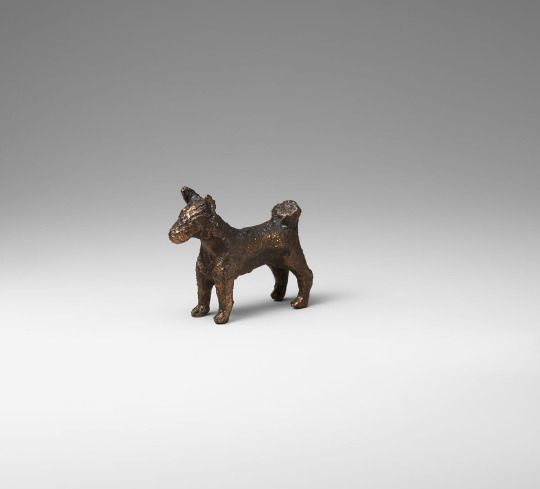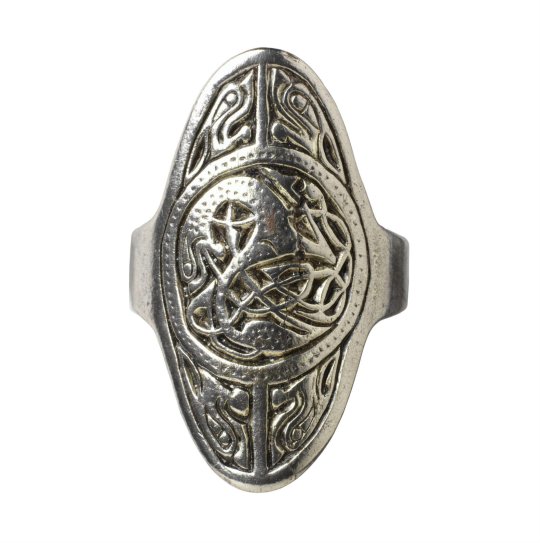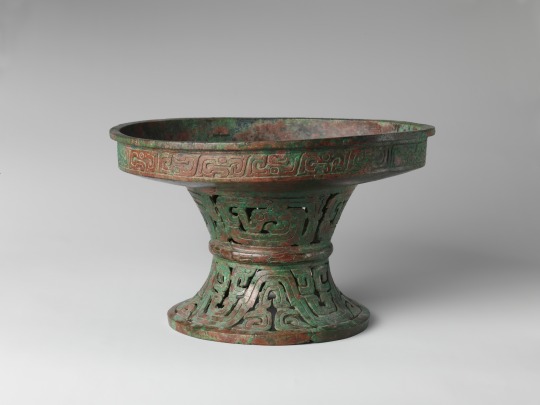#8th-9th century
Text
New ship grave found in Norway
Over 1,200 years ago, a very special tradition was established in the Viking Age: the burial of rulers in so-called ship graves. Deceased kings were buried in large ships and then buried together with their nautical coffins under large mounds. Norway is particularly prominent in this tradition. Already in the late 19th century, two such graves were discovered in the south-west of the country in the municipality of Karmøy.

The georadar image of the new ship grave Salhushaugen
Now, as part of the research project Avaldsnes - Port of Power, 2022, these were re-examined with the help of georadar measurements and the nearby third burial mound, which was thought to be empty, was also re-examined and, to everyone's surprise, it is not empty. On the contrary, there is probably still a ship there, according to the data. The new grave has not yet been dated, but it could also be from the 8th or early 9th century, like the other two Storhaug and Grønhaug. The ship itself could be about 17-20 m long and may have been the grave of a king or other very important person (it is assumed that there was a king, but the ship graves were also used by women of high rank).

The three ship graves Storhaug, Salhushaugen and Grønhaug. In terms of both the size of the ship and the burial mound, Storhaug is probably the most impressive of the three tombs. But shortly after it was built, Salhushaugen was no small mound either, with a diameter of 50 metres and a height of almost 6 metres.
Whether the remains of the king who was presumably buried there or his belongings have also been preserved in Salhushaugen cannot yet be concretely confirmed by the georadar measurements alone. Further investigations, including excavations, must follow.
75 notes
·
View notes
Text




~ Cylinder Vessel with Palace Scene.
Place of origin: Guatemala, Petén, Dos Pilas or vicinity
Culture: Maya, lk style
Date: A.D. 740–800
Medium: Slip-painted ceramic with post-fire pigment.
#8th century#9th century#cylinder vessel#ceramics#palace scene#petén#dos pilas#guatemala#ik style#maya#mayan#pigment#Mesoamerica#pre columbian#a.d. 740#a.d. 800#history#museum#archeology#archaeology
734 notes
·
View notes
Text
when you're being mean to me this is who you're being mean to. btw

#tagamemnon#i am in fact bronze assyrian dog figurine ca. 9th-8th century bc#queueusque tandem abutere catilina patientia nostra
330 notes
·
View notes
Photo

Islamic Conquest Between 7th and 9th Century.
133 notes
·
View notes
Text

Day 4: Queen - Irene Sarantapechaina
#jenstober23#irene sarantapechaina#irene of athens#empress irene#byzantium#byzantine empire#byzantine emperor#history art#traditional art#8th century#9th century#inktober#inktober 2023#drawtober#drawtober 2023#artober#artober 2023#witchtober#witchtober 2023#day 4#greek tag#roman tag
31 notes
·
View notes
Text

A silver ring, dated 775-850, found in the Thames in 1856
From the Victoria & Albert Museum
19 notes
·
View notes
Text

Food serving vessel (Pu), late 9th–early 8th century BCE
Western Zhou dynasty (1046–771 BCE), China
Bronze
H. 6 1/8 in. (15.5 cm); Diam. 9 1/2 in. (24.1 cm)
Collection of the Metropolitan Museum of Art
#Chinese#bronze#Western Zhou dynasty#zhou dynasty#art#art history#9th century bce#8th century bce#The Met#metropolitan museum of art#metal
8 notes
·
View notes
Text


✨ 2 New Swords form Fafnir Forge✨
Viking Warrior Sword 8th to 10th Century
and
Single Edge Viking Sword
🗡️ Kult of Athena’s Fafnir Forge line delivers a historical Viking line that an affordable price point.
#Kult of Athena#KultOfAthena#Fafnir Forge#Viking Warrior Sword#Viking Warrior sword 8th to 10th Century#Single Edge Viking Sword#sword#swords#weapon#weapons#blade#blades#Viking Swords#Viking Weapons#8th century#9th century#10th century#Type H Sword#Viking Age#EN45 High Carbon Steel#Battle Ready#European Swords#European Weapons
3 notes
·
View notes
Text

Rogan a Goryvlad zo série Černokňažník
Autor - Lucia Húšťavová
#juraj cervenak#historical fantasy#rogan#goryvlad#fanart#8th century#9th century#Great Moravia#Avar Kaghanate#early medieval#wolf#warrior#archer#warlock#Černokňažník#sword and sorcery#slavic mythology
2 notes
·
View notes
Text
In the 750s the pope in Rome sought their protection against local bullies, and on Christmas morning, 800, the Frankish king Charlemagne* was even able to get Pope Leo III to kneel before him in St. Peter's and crown him Roman emperor.
*Charlemagne's actual name was Carolus; Charlemagne is a Gallicized version of Carolus Magnus, "Charles the Great."
"Why the West Rules – For Now: The patterns of history and what they reveal about the future" - Ian Morris
#book quotes#why the west rules – for now#ian morris#nonfiction#charlemagne#8th century#9th century#protection#bullies#christmas morning#pope leo iii#roman emperors#carolus magnus
0 notes
Text

~ Children's Toy - Сockerel.
Place of origin: Karachay-Cherkessia, Russia
Culture: Early medieval culture of the Adygo-Alanian tribes
Date: A.D. 8th-9th century
Place of origin: North-western Caucasus, Karachayevo-Cherkessk Republic; Archaeological site: Moshchevaya Balka Burial Mound
Medium: Leather, thread, silk.
#history#museum#archeology#archaeology#children's toy#russia#russian#8th century#9th century#cockerel#karachay cherkessia#medieval#early medieval#Adygo-Alanian tribes#caucasus#leather
908 notes
·
View notes
Photo

Bronze statuette (of a woman?). 9th–8th century BCE. Credit line: Purchase, 1896 https://www.metmuseum.org/art/collection/search/246286
#aesthetic#art#abstract art#art museum#art history#The Metropolitan Museum of Art#museum#museum photography#museum aesthetic#dark academia
263 notes
·
View notes
Text

Byzantine consorts/Augustae: Aelia Verina - Euphrosyne Porphyrogenita
457 AD - 829 AD
I am all caught up for now! Time to get back to actually listening to the podcast…
#digital art#history art#byzantine empire#byzantine empress#byzantium#empress theodora#pride#gay#5th century#6th century#7th century#8th century#9th century#roman tag#greek tag
26 notes
·
View notes
Text
Although the invading Germanic tribes admired many Roman institutions, the baths were not among them. Their preference was for a manly dip in a stream, at least in warm weather. (The Romans thought the invaders smelled vile, in part because they dressed their hair with rancid butter.)
By the eighth and ninth centuries, mistrusted by the Christians and neglected by the Germanic conquerors, the baths in the West had fallen into disrepair and were finally abandoned.
The baths lasted longer in the eastern part of the Byzantine Empire. In sixth-century Alexandria, one-third of the city’s budget was spent in heating the baths.
0 notes
Text

Multicolored glass jug, Egypt or Syria, 8th-9th century
from The Al-Sabah Collection
221 notes
·
View notes
Text
youtube
Graceful gestures and terrifying guardians — Tang Tomb figures, November 7, 2021
Polychrome figures (sancai), 618–907 C.E. (Tang dynasty), white clay, lead oxide flux and glazes colored with copper, iron, manganese, and cobalt; fired at 800 degrees Celsius (Shanghai Museum)
A conversation between Dr. Kristen Loring Brennan and Dr. Beth Harris.
Smarthistory
#tang dynasty#Chinese#art#art history#figure#sculpture#fashion#religion#period dress#cultural amalgam#sancai#colour#Shanghai Museum#7th century#8th century#9th century#10th century#Youtube#盂蘭盆#中元節#ghost festival
7 notes
·
View notes